Electrical properties of Indium Antimonide (InSb)

Electrical properties
Basic ParametersMobility and Hall Effect
Transport Properties in High Electric Fields
Impact Ionization
Recombination Parameters
Basic Parameters
| Breakdown field | ≈103 V cm-1 |
| Mobility Electrons | ≤7.7·104 cm2V-1s-1 |
| Mobility Holes | ≤850 cm2V-1s-1 |
| Diffusion coefficient Electrons | ≤2·103 cm2s-1 |
| Diffusion coefficient Holes | ≤22 cm2s-1 |
| Electron thermal velocity | 9.8·105 m s-1 |
| Hole thermal velocity | 1.8·105 m s-1 |
Mobility and Hall Effect
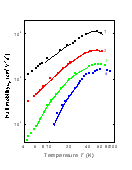 |
Electron Hall mobility versus temperature for different doping levels and different compensation ratios
|
|||||||||||||||
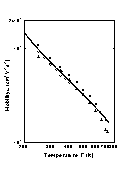 |
Electron mobility versus temperature (high temperatures). Solid line is theoretical calculation for electron-drift mobility. Experimental data are Hall mobilities. (Rode [1971]). |
µnH≈7.7·104(T/300)-1.66 (cm2 V-1 s-1).
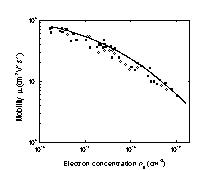 |
Electron mobility versus electron concentration. T = 300 K (Litwin-Staszewska et al. [1981]). |
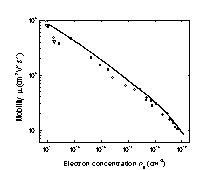 |
Electron mobility versus electron concentration. T = 77 K (Litwin-Staszewska et al. [1981]). |
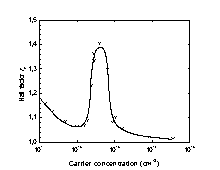 |
The electron Hall factor versus carrier concentration. T = 77 K (Baranskii and Gorodnichii [1969]). |
| Maximal electron mobility for pure n-InSb | |
77 K |
1.2·106 cm2V-1s-1 |
300 K |
7.7·104 cm2V-1s-1 |
| Maximal electron mobility for InSb grown on GaAs substrate | |
77K |
1.5·105 cm2V-1s-1 (no= 2.2·1015 cm-3) |
300 K |
7.0·104 cm2V-1s-1 (no= 2.0·1016 cm-3) |
| Maximal electron mobility for InSb grown on InP substrate | |
77 K |
1.1·105 cm2V-1s-1 |
300 K |
7.0·104 cm2V-1s-1 |
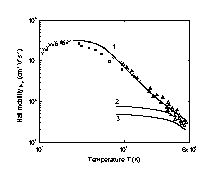 |
Hole Hall mobility versus temperature for different hole concentrations. po (cm-3): 1. 8·1014; 2. 3.15·1018; 3. 2.5·1019; (Zimpel et al. [1989]) and (Filipchenko and Bolshakov [1976]). |
µpH≈850(T/300)-1.8 (cm2V-1s-1)
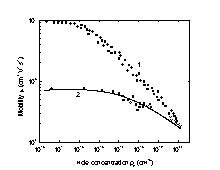 |
Hall mobility versus hole concentrations: 1. 77 K (Filipchenko and Bolshakov [1976]); 2. 290K (Wiley [1975]). |
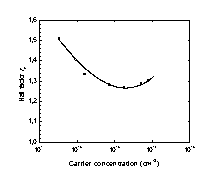 |
The hole Hall factor versus carrier concentration, 77 K (Baranskii and Gorodnichii [1969]). |
Transport Properties in High Electric Fields
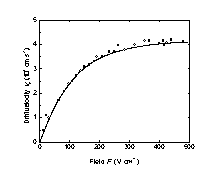 |
Field dependence of the electron drift velocity, 77 K. Solid lines is the Monte Carlo calculation. Points are experimental data. (Asauskas et al. [1980]). |
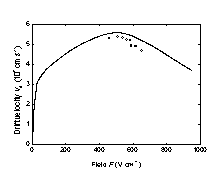 |
Field dependence of the electron drift velocity, 77 K. Solid lines is the Monte Carlo calculation. Points are experimental data. (Neukermans and Kino [1973]). |
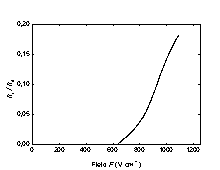 |
Fraction of electrons in the L-valley as a function of electric field F, 77K (Asauskas et al. [1980]). |
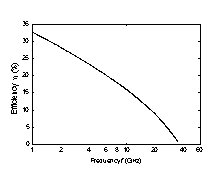 |
Frequency dependence of the efficiency in LSA mode Fo = F + F1sin(2π·ft): Fo= 2.5 kV cm-1 (Prokhorov et al. [1977]). |
Impact Ionization
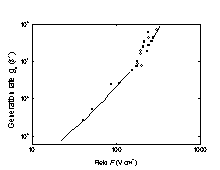 |
The dependence of generation rate for electrons gn versus electric field F, 300 K (Vorob'ev et al. [1983]). |
gn(F) = 126·F2exp(F/160) (s-1),where F is in V cm-1.
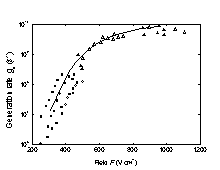 |
The dependence of generation rate for electrons gn versus electric field F, 77 K (Krotkus and Dobrovolskis [1988]) and (Vorob'ev et al. [1988]). |
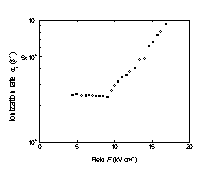 |
The dependence of ionization rates for electrons αi versus the electric field F, T=78 K (Gavrushko et al. [1978]). |
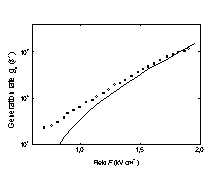 |
The dependence of generation rate for holes gp versus the electric field F, T =77K (Adomaitis et al. [1985]). |
Recombination Parameters
For pure InSb at T≥250K lifetime of carrier (electrons and holes) is determined by Auger recombination:τn = τp ≈1/C ni2,
where C≈5·10-26 cm-6 s-1 is the Auger coefficient.
ni is the intrinsic carrier concentration.
| For T = 300 K | τn = τp≈5·10-8 s |
| For T = 77K | |
n-type: the lifetime of holes |
τp ~ 10-6 s |
p-type: the lifetime of electrons |
τn ~ 10-10 s |
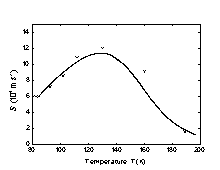 |
Temperature dependence of surface recombination velocity for p-InSb. (Euthymiou et al. [1981]). |
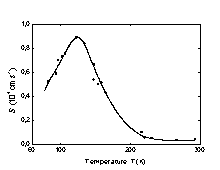 |
Temperature dependence of surface recombination velocity for n-InSb. (Skountzous and Euthymiou [1976]). |
| Radiative recombination coefficient | ~5·10-11 cm3s-1 |
| Auger coefficient | ~5·10-26 cm6s-1 |